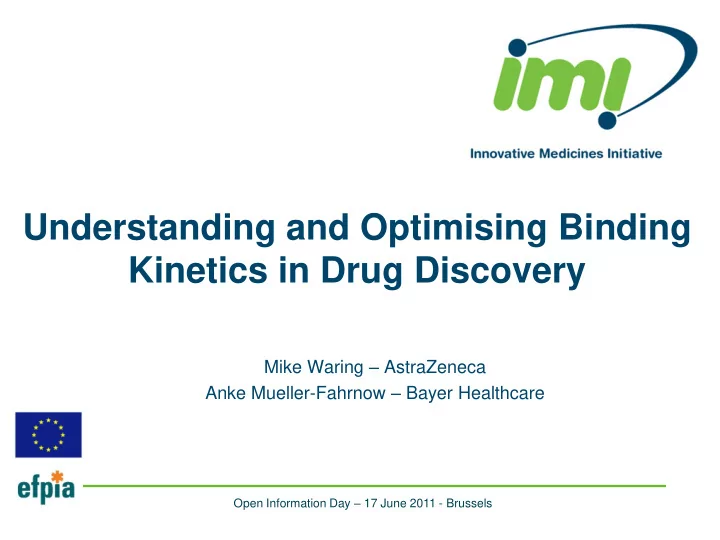

Understanding and Optimising Binding Kinetics in Drug Discovery Mike Waring – AstraZeneca Anke Mueller-Fahrnow – Bayer Healthcare Open Information Day – 17 June 2011 - Brussels
The Problem • Compounds can be clinically differentiated by their binding kinetics • Compounds with optimum kinetics will suffer reduced attrition in development • Currently, such compounds are found by chance and realised late Open Information Day – 17 June 2011 - Brussels
Objectives of the full project • Understanding binding kinetics at a molecular level – Molecular interactions and conformational changes – Relationship between thermodynamics and kinetics – X-ray, NMR, SPR etc. – Computational modelling – Ability to design appropriate kinetic behavior rationally • Assay technologies – Evaluation and standardisation of existing technology – Generation of new higher throughput methodology – Applicability to membrane proteins – Information feedback in a DMTA cycle timeframe • Understanding in vivo translation – In vivo models – PKPD modelling – Scaling to man – Confidence that in vitro effects will lead to clinical differentiation Open Information Day – 17 June 2011 - Brussels
Expected impact on the R&D process • Compounds with optimised kinetic profiles will be more likely to succeed in development and hence attrition will be reduced • Ability to bring this about by design will lead to more compounds with appropriate kinetics being progressed Open Information Day – 17 June 2011 - Brussels
Need for public-private collaboration • Previous work has been sporadic and knowledge kept within individual projects • Pooled expertise and complete, consistent datasets • Structural, biophysical, pharmacological (both in vitro and in vivo ) and chemical experts • Tool compounds, assay reagents and in vivo models • Of interest to potential academic collaborators Open Information Day – 17 June 2011 - Brussels
Pre-competitive nature • Systems will be provided that EFPIA members are willing to share freely • Data made available to all • Deliverables should have general relevance and not be specific to individual targets Open Information Day – 17 June 2011 - Brussels
Suggested architecture of the project • All aspects of the proposal to be addressed through collaboration • Other innovative proposals welcomed • Workpackage1 – Molecular understanding • Work package 2 - Assay technology • Work package 3 – Link to in vivo Open Information Day – 17 June 2011 - Brussels
Expected contributions of the applicants • Proposals targeted at any of the three areas outlined • Consortium will coordinate studies and ensure knowledge is shared • Molecular understanding • Determination individual contributions to on and off rates to allow the analysis which could lead to general considerations for optimization of these parameters • Prediction of protein conformational changes which may be tested with the proposed systems to assess their future predictive value • Assay technology • New methodologies that address the identified short comings of current technology • Development of methods that are applicable to membrane proteins • Link to in vivo • Study of binding events in open systems such as cells, isolated tissues and ultimately in vivo models • Understanding additional phenomena governing receptor occupancy in these more complex systems • Comparing systems which translate from isolated enzyme and those that do not Open Information Day – 17 June 2011 - Brussels
Expected (in kind) contributions of EFPIA members • Entirely in kind. • FTEs for coordination of the consortium, intellectual input and experimental work (~1 to 2 FTEs / company) • Appropriate targets / systems and selected tool compounds • In vivo probe compounds / models • Computational support (molecular modelling & dynamics, systems biology) • Coordination, active participation and input • Hosting post doctoral workers and students in industrial laboratories to provide access to technology and assays Open Information Day – 17 June 2011 - Brussels
What’s in it for you? • Academics – Fundamental science (understanding molecular interactions) with direct societal and economic impact – Opportunity for collaborative research not possible individually • SMEs – Marketable technology platforms • Patient groups – More efficacious, safer medicines – More stable, secure pharmaceutical industry Open Information Day – 17 June 2011 - Brussels
Key deliverables of full project • Guidelines for understanding the molecular phenomena that allow manipulation of kinetics by design • Technology evaluation using agreed benchmark tool compounds and molecular systems • Improved methods and recommendations for obtaining high(er) throughput kinetic measurements • Robust, predictive PKPD kinetic modeling paradigms • Enhanced data-sharing within the network of drug binding and kinetics • Reduced attrition in drug development Open Information Day – 17 June 2011 - Brussels
Questions? infodesk@imi.europa.eu www.imi.europa.eu Open Information Day – 17 June 2011 - Brussels
Recommend
More recommend